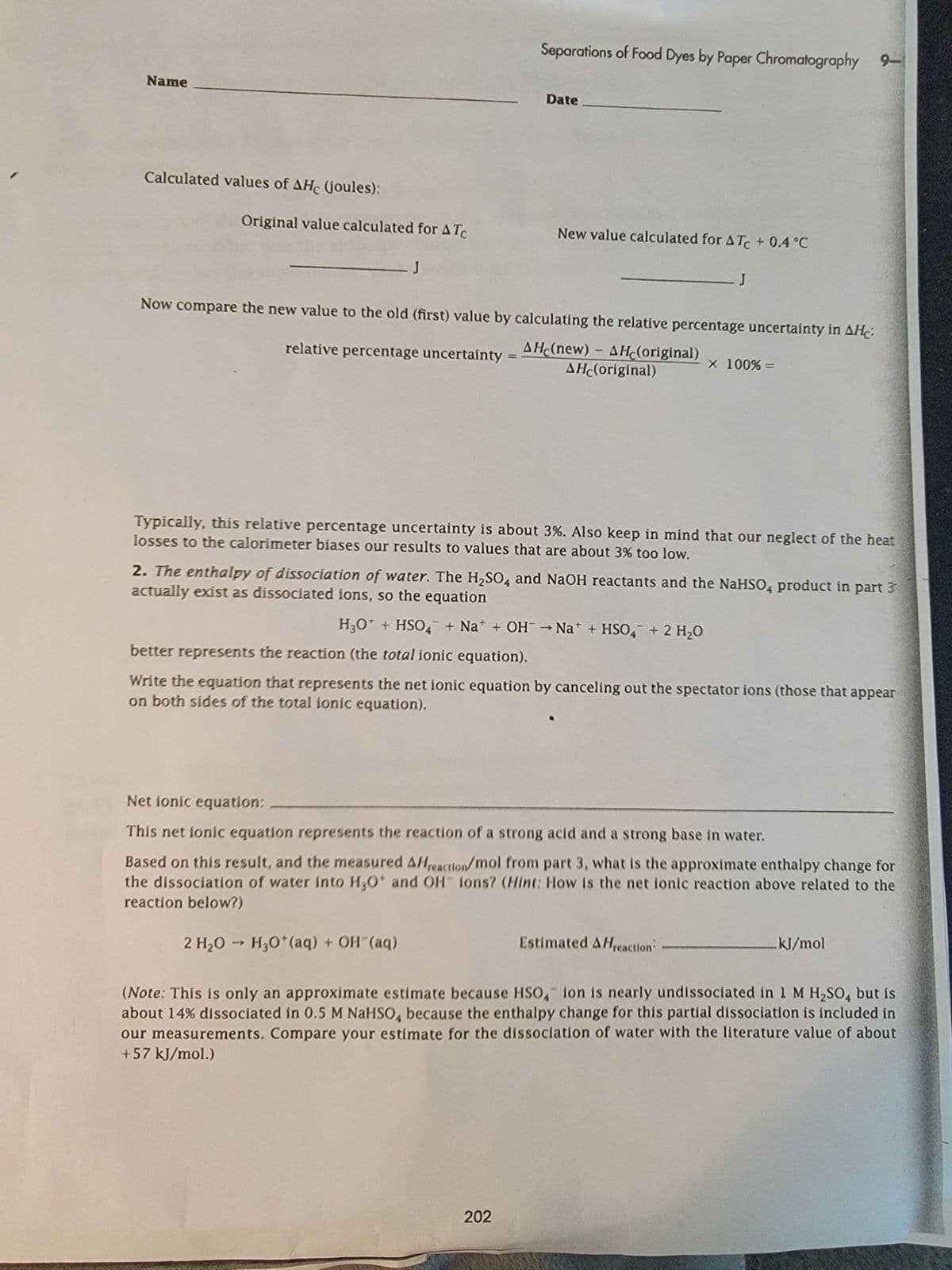Name Calculated values of AHC (joules): Separations of Food Dyes by Paper Chromatography 9- Date Original value calculated for ATC New value calculated for ATC +0.4 °C J J Now compare the new value to the old (first) value by calculating the relative percentage uncertainty in AHc: relative percentage uncertainty AH(new) AH(original) AHC(original) × 100% = Typically, this relative percentage uncertainty is about 3%. Also keep in mind that our neglect of the heat losses to the calorimeter biases our results to values that are about 3% too low. 2. The enthalpy of dissociation of water. The H2SO4 and NaOH reactants and the NaHSO4 product in part 3 actually exist as dissociated ions, so the equation H3O+ HSO4 + Na + OH → Na+ + HSO4 + 2 H₂O better represents the reaction (the total ionic equation). Write the equation that represents the net ionic equation by canceling out the spectator ions (those that appear on both sides of the total ionic equation). Net ionic equation: This net ionic equation represents the reaction of a strong acid and a strong base in water. Based on this result, and the measured AH reaction/mol from part 3, what is the approximate enthalpy change for the dissociation of water into H₂O' and OH lons? (Hint: How is the net ionic reaction above related to the reaction below?) 2 H2O → H3O+ (aq) + OH(aq) Estimated AHreaction kJ/mol (Note: This is only an approximate estimate because HSO4 ion is nearly undissociated in 1 M H2SO4 but is about 14% dissociated in 0.5 M NaHSO4 because the enthalpy change for this partial dissociation is included in our measurements. Compare your estimate for the dissociation of water with the literature value of about +57 kJ/mol.) 202
Name Calculated values of AHC (joules): Separations of Food Dyes by Paper Chromatography 9- Date Original value calculated for ATC New value calculated for ATC +0.4 °C J J Now compare the new value to the old (first) value by calculating the relative percentage uncertainty in AHc: relative percentage uncertainty AH(new) AH(original) AHC(original) × 100% = Typically, this relative percentage uncertainty is about 3%. Also keep in mind that our neglect of the heat losses to the calorimeter biases our results to values that are about 3% too low. 2. The enthalpy of dissociation of water. The H2SO4 and NaOH reactants and the NaHSO4 product in part 3 actually exist as dissociated ions, so the equation H3O+ HSO4 + Na + OH → Na+ + HSO4 + 2 H₂O better represents the reaction (the total ionic equation). Write the equation that represents the net ionic equation by canceling out the spectator ions (those that appear on both sides of the total ionic equation). Net ionic equation: This net ionic equation represents the reaction of a strong acid and a strong base in water. Based on this result, and the measured AH reaction/mol from part 3, what is the approximate enthalpy change for the dissociation of water into H₂O' and OH lons? (Hint: How is the net ionic reaction above related to the reaction below?) 2 H2O → H3O+ (aq) + OH(aq) Estimated AHreaction kJ/mol (Note: This is only an approximate estimate because HSO4 ion is nearly undissociated in 1 M H2SO4 but is about 14% dissociated in 0.5 M NaHSO4 because the enthalpy change for this partial dissociation is included in our measurements. Compare your estimate for the dissociation of water with the literature value of about +57 kJ/mol.) 202
Chapter7: Statistical Data Treatment And Evaluation
Section: Chapter Questions
Problem 7.21QAP
Question
I am not sure on setting up the net ionic equation in the begining of part 2.

Transcribed Image Text:Name
Calculated values of AHC (joules):
Separations of Food Dyes by Paper Chromatography 9-
Date
Original value calculated for ATC
New value calculated for ATC +0.4 °C
J
J
Now compare the new value to the old (first) value by calculating the relative percentage uncertainty in AHc:
relative percentage uncertainty
AH(new) AH(original)
AHC(original)
× 100% =
Typically, this relative percentage uncertainty is about 3%. Also keep in mind that our neglect of the heat
losses to the calorimeter biases our results to values that are about 3% too low.
2. The enthalpy of dissociation of water. The H2SO4 and NaOH reactants and the NaHSO4 product in part 3
actually exist as dissociated ions, so the equation
H3O+ HSO4 + Na + OH → Na+ + HSO4 + 2 H₂O
better represents the reaction (the total ionic equation).
Write the equation that represents the net ionic equation by canceling out the spectator ions (those that appear
on both sides of the total ionic equation).
Net ionic equation:
This net ionic equation represents the reaction of a strong acid and a strong base in water.
Based on this result, and the measured AH reaction/mol from part 3, what is the approximate enthalpy change for
the dissociation of water into H₂O' and OH lons? (Hint: How is the net ionic reaction above related to the
reaction below?)
2 H2O → H3O+ (aq) + OH(aq)
Estimated AHreaction
kJ/mol
(Note: This is only an approximate estimate because HSO4 ion is nearly undissociated in 1 M H2SO4 but is
about 14% dissociated in 0.5 M NaHSO4 because the enthalpy change for this partial dissociation is included in
our measurements. Compare your estimate for the dissociation of water with the literature value of about
+57 kJ/mol.)
202
Expert Solution
This question has been solved!
Explore an expertly crafted, step-by-step solution for a thorough understanding of key concepts.
Step by step
Solved in 2 steps

Recommended textbooks for you



Chemistry & Chemical Reactivity
Chemistry
ISBN:
9781133949640
Author:
John C. Kotz, Paul M. Treichel, John Townsend, David Treichel
Publisher:
Cengage Learning



Chemistry & Chemical Reactivity
Chemistry
ISBN:
9781133949640
Author:
John C. Kotz, Paul M. Treichel, John Townsend, David Treichel
Publisher:
Cengage Learning

Principles of Instrumental Analysis
Chemistry
ISBN:
9781305577213
Author:
Douglas A. Skoog, F. James Holler, Stanley R. Crouch
Publisher:
Cengage Learning